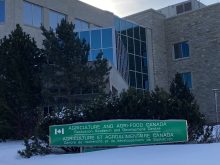The use of the term food miles is growing in popular media, but what does it mean for Canadian farmers?
Most western Canadian food is exported, in some years as much as 80 percent.
Saskatchewan’s high volume of production is the most dependent on the export market but also the least reliant on the U.S. market, which means a greater percentage of the harvest goes off-shore compared to the rest of the country.
Saskatchewan food travels across the globe to almost every country in the world. Is this sustainable? How do we know?
Read Also

Kochia has become a significant problem for Prairie farmers
As you travel through southern Saskatchewan and Alberta, particularly in areas challenged by dry growing conditions, the magnitude of the kochia problem is easy to see.
The term food miles was first used in a 1994 report from the United Kingdom to highlight the environmental and social impacts caused by the increasing distances that food was travelling.
It has been widely adopted by local food movements and used to promote the widespread growth of initiatives such as farmers’ markets.
Buyers, retailers and consumers are increasingly using it when making purchasing decisions. It’s even beginning to appear in government policies.
Interestingly, the term is commonly used as a surrogate measure for greenhouse gas emissions from food sources.
The implication for exporters is a potential reduction in access to overseas markets due to perceived higher costs, higher landing fees and carbon taxes based on freight tonnage.
In reality, the food miles debate is about much more than greenhouse gas emissions from transportation. The transportation component of the global food chain is only a small factor in total energy use, 10 to 14 percent at most.
Food miles are part of a wider debate about globalization versus localization and about sustainable systems of production and consumption.
New Zealand is a leader in using food miles to its advantage in the export market. This was a necessity given its large food production capacity relative to a small population.
Today, this remote nation successfully exports commodities and processed food around the world.
The agricultural industry in New Zealand has proactively built a global reputation for sustainable production systems and environmentally friendly marketing abroad.
The industry has used life cycle assessments when researching their food production’s environmental footprint. This demonstrated that selected New Zealand food products can be exported to Europe and North America with lower greenhouse gas emissions than locally produced products.
The knowledge and awareness pro-v ided by life cycle assessments helped New Zealand farmers adjust the production mix of their crops and livestock to produce and export food that is proven to be more environmentally, economically and socially sustainable.
Leaders in Canadian agriculture are beginning to use the life cycle assessment tool as a way to measure the environmental and social impact of the food chain from the tillage of the land to management of inputs and positioning for export.
Local markets may increase for some farmers, but most Canadian crops and livestock will still be destined for export.
The good news is that the Canadian agricultural industry can use food miles to its advantage, for both local and global markets, by being proactive.
Like New Zealand, Canadian farmers need to show that even though the food miles may be high, some products can still be the best overall environmental choices for customers around the world.
Al Scholz is a farm business management adviser, policy consultant in sustainable food production, an international project manager, author and conference speaker.
















